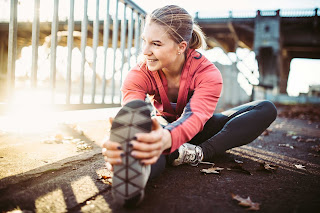Think you need to be a yoga pro in order to balance on one foot? Think again. Practice these exercises to improve your balance and overall confidence.
Balance exercise: Tadasana (“mountain pose”)

Tadasana, or “mountain pose,” is a staple in yoga practices to work total balance. While it may seem like an inactive pose, it helps to focus the body and overall awareness while improving balance and posture. With your feet parallel and hip width distance apart, stand with your shoulders relaxed and gaze forward. As you inhale, bring your arms up and overhead next to your ears, again pulling the shoulders down. Exhale as your bring your arms back to your sides. Alison West, PhD and ERYT, says this may not feel like a strengthening exercise, but you are opening the front of the chest, increasing breathing capacity, and blood circulation, necessary health factors when building muscle strength. Danielle Prager of Jivamuukti Yoga reminds us “even in Tadasana the energy is moving up the back and down the legs.” By nourishing and strengthening tissues, West says you are elevating your mood and building physical confidence.
Balance exercise: Standing plank

“Connecting the legs to the spine is critical [to] how you stand up,” says West. “If you don’t know basic posture, it’s going to be hard to have basic balance.” To modify traditional plank, try a standing plank by coming into a plank position against the wall. This will “change your relationship to gravity,” West says, and will help to strengthen your front core. Engage your muscles by extending your arms out and pushing against the wall, keeping your shoulders down and relaxed. To add on, lift your heels for calf strengthening and foot flexibility work, both important in overall balance. You can move into a side plank by shifting to one arm and opening the chest, adjusting your feet by walking them out a little more. Be sure to switch sides.
Balance exercise: Doorframe movements

No need for fancy exercise instruments here. West recommends using a doorframe to give yourself a sense of axle extension along your spine, bringing your lower abdominal muscles into play. “Put yourself on the corner of a doorframe, with your heels near the corner, sacrum on the corner, thoracic spine on the corner… and just bend the knees and lengthen up along that as if you’re trying to be measured,” West says. You can additionally use the frame to begin to do standing poses, such as “Warrior 1.” All standing poses begin to build core strength, says West, which ultimately helps you keep upright and balanced. To take Warrior 1 inside the doorframe, bring your hands to the frame once more. Come into a high lunge, bending the front knee and stepping the back foot out at about a 45-degree angle. Hold this position for a few breaths, then switch sides.
Balance exercise: Seat of Isis

Prager says immediate benefits of balance work include better posture and a relief from the physical ailments that accompany slouching, leaning, and compressing the body. “Learning to balance on your feet can lead to increased confidence, better fitting clothing, and fewer falls and bone fractures,” Prager says. Coming to a relaxed standing pose, extend the left foot forward, bringing it one to two inches off the floor. As you exhale, flex the left foot; as you inhale, point the foot. Repeat this motion three times, then inhale and step down with the ball of the left foot as the right heel comes up. Begin to bend both knees as you float your arms to shoulder height, palms facing up. Inhale and turn the palms down as you begin to straighten the legs once more. Exhale bend and inhale extend five times on the balls of your feet. On your final exhale, drop the right heel and bring your left foot back, drawing it to the chest if you are able. Bring both heels together, then repeat the movements with your right foot extended forward.
Balance exercise: Bending tree

To come into a bending tree, stand first in mountain pose, rooting the corner of your feet to the ground. Inhale and begin to bring your left knee toward your chest, then exhale as you turn it out and place it against your right inner thigh or calf, avoiding the right knee. Once you’re here, Prager says to bring your hands to a prayer position at heart center. To move on, bring your hands slowly overhead, then begin to exhale as you begin bending to your left side. Lean for five breaths. Inhale and slowly begin to come back to your standing tree, then gently release. Switch sides. Practice this exercise with the support of a wall as you gradually develop your balance.
Balance exercise: Navasana (“boat pose”)

Prager reiterates that it is important to remember that balance does not just mean our feet, which is why yoga practitioners will balance on their hands, head, and seat. “’Asana’ means seat, and seat is your connection to the earth,” she says. “All of the poses in general are beneficial to core strength as we are conducting the energy from the Earth to the Sky. You have to press down to lift up, so the energy moves up and down, through the core.” For Navasana, sit on the floor with your legs straight. Press your hands into the floor behind your hips, your fingertips facing forward. Begin to lean back and lift your heart, avoiding rounding the back. Inhale and lift your arms so they become parallel with the floor, then exhale and bend your knees, bringing your feet off of the floor. You should feel your core activate. To make the exercise more difficult, begin to extend your legs. Prager says to lift the sternum and lengthen the tailbone, reaching through the fingertips. Engage your lower abdomen as you lengthen the back of the neck, reaching the top of the skull towards the sky. To modify, bring your hands back alongside your hips. Stay here for five to 10 breaths, then take a break. Increase your breaths with every repetition.
Balance exercise: Ukatasana (with chair or without)

Ukatasana means “chair pose”—but it can be done with a chair or without one. The pose strengthens the ankles, calves, and thighs. First taking Tadasana, inhale and take arms out to your side or up next to your ears, says West. This move will strengthen the back. Begin to lean forward and bend your knees, trying to make the thighs parallel to the floor and holding your torso up. This will ensure the back body will have to work, says West. If using the chair, try to use it for alignment, unless the exercise becomes too much. If sitting in the chair, lean side to side, keeping the shoulders relaxed and down your spine. To come out of the pose, root through the feet and straighten your knees as you inhale, lifting through the arms. As you exhale, come back to Tadasana with your arms by your side.
























